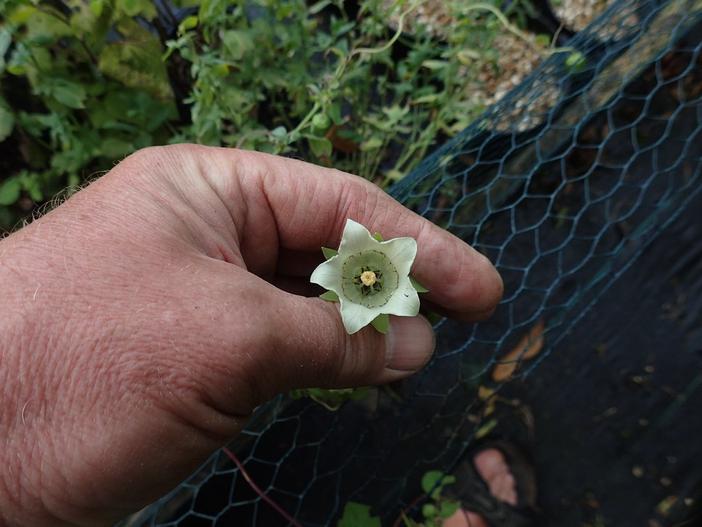Dangshen
(Codonopsis tangshen)
Dangshen (Codonopsis tangshen)
/
/

peganum
CC BY-SA 2.0
Image By:
peganum
Recorded By:
Copyright:
CC BY-SA 2.0
Copyright Notice:
Photo by: peganum | License Type: CC BY-SA 2.0 | License URL: https://creativecommons.org/licenses/by-sa/2.0/ | Uploader: peganum | Publisher: Flickr




Estimated Native Range
Summary
Codonopsis tangshen, commonly known as Dangshen, is a perennial herb native to forest margins, meadows, and scrublands in China. It is part of the bellflower family and is known for its twining stems that can reach up to 2 meters (6.6 feet) in length. The plant features solitary, bell-shaped flowers at the branch tips, each about 2 cm (0.8 in) long and wide, colored yellow-green with distinctive purple spots inside. Dangshen typically blooms in the late summer months and the flowers are modestly showy, attracting pollinators such as bees and butterflies.
Dangshen is valued for its medicinal properties, particularly in traditional Chinese medicine, where it is used as a substitute for ginseng. The roots are harvested for their purported health benefits, which include boosting the immune system and increasing energy levels. In cultivation, it is often grown for its ornamental foliage and flowers, as well as for its medicinal roots. Gardeners should provide it with full sun to part shade, ensure medium water availability, and plant it in soil with slow to medium drainage to mimic its natural habitat conditions. While not commonly grown in Western gardens, it can be an interesting addition to herb gardens or used in mixed borders for its twining habit and unique flowers. Potential problems include slugs and snails, which may damage the foliage, and root rot if grown in poorly drained soils.CC BY-SA 4.0
Dangshen is valued for its medicinal properties, particularly in traditional Chinese medicine, where it is used as a substitute for ginseng. The roots are harvested for their purported health benefits, which include boosting the immune system and increasing energy levels. In cultivation, it is often grown for its ornamental foliage and flowers, as well as for its medicinal roots. Gardeners should provide it with full sun to part shade, ensure medium water availability, and plant it in soil with slow to medium drainage to mimic its natural habitat conditions. While not commonly grown in Western gardens, it can be an interesting addition to herb gardens or used in mixed borders for its twining habit and unique flowers. Potential problems include slugs and snails, which may damage the foliage, and root rot if grown in poorly drained soils.CC BY-SA 4.0
Plant Description
- Plant Type: Vine
- Height: 4-5 feet
- Width: 0.7-1 feet
- Growth Rate: Moderate
- Flower Color: Yellow, Green
- Flowering Season: Summer
- Leaf Retention: Deciduous
Growth Requirements
- Sun: Full Sun
- Water: Medium
- Drainage: Slow, Medium
Common Uses
Deer Resistant, Low Maintenance
Natural Habitat
Forest margins, meadows, and scrublands in China
Other Names
Common Names: Chuan Dang, Bellflower, Ginsengklocka, Chuan Dang Shen
Scientific Names: , Codonopsis tangshen, Codonopsis pilosula subsp. tangshen,
GBIF Accepted Name: Codonopsis pilosula subsp. tangshen (Oliv.) D.Y.Hong